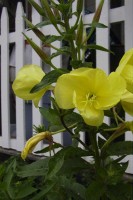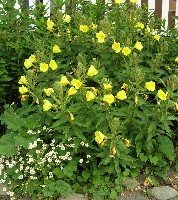 Among the many plants recommended for children, there are those that feel good (Lambs’ ears comes to mind) and those that smell good (take your pick) and those that taste good (herbs), but this is one of the few plants I know that’s fun to watch.
Among the many plants recommended for children, there are those that feel good (Lambs’ ears comes to mind) and those that smell good (take your pick) and those that taste good (herbs), but this is one of the few plants I know that’s fun to watch.
Known by the ungainly name of Red-Sepaled Evening Primrose, it has larger flowers than many of the weedier evening primroses that you may be familiar with. These flowers bloom in the evening, near dusk. What makes them so much fun to watch is the speed with which the blossoms open–literally right before your eyes. You pick out a prospective bloomer by noticing the cracks in the bud case revealing the yellow blossom within. Just keep your eyes fixed on it. Soon it will give a little shimmy and then unfurl into a four-inch flower with a light, pleasing scent.
 This plant is a biennial, which means you’ll have to wait a whole year for the show. The first year, as with many biennials, it forms a low rosette of leaves. To my eye, these rosettes are indistinguishable from those of Oenothera biennis, a weed commonly found in my area, so I often wind up pulling second year plants that turn out to be the less desirable species. The second year O. glazioviana can grow as large as a smallish shrub, as you can see from the second photo. It can self-sow in prodigious amounts, so be sure to deadhead at least 50% of the seed pods to prevent an invasion. According to Carroll Gardens, if you remove all the seed pods your plant may last for several years. I’ve never tried it myself, but I’ve noticed the same behavior with other plants.
This plant is a biennial, which means you’ll have to wait a whole year for the show. The first year, as with many biennials, it forms a low rosette of leaves. To my eye, these rosettes are indistinguishable from those of Oenothera biennis, a weed commonly found in my area, so I often wind up pulling second year plants that turn out to be the less desirable species. The second year O. glazioviana can grow as large as a smallish shrub, as you can see from the second photo. It can self-sow in prodigious amounts, so be sure to deadhead at least 50% of the seed pods to prevent an invasion. According to Carroll Gardens, if you remove all the seed pods your plant may last for several years. I’ve never tried it myself, but I’ve noticed the same behavior with other plants.
At one point Select Seeds offered this as ‘Tina’s Magic Primrose,’ presumably named after Tina James, mentioned in the Carroll Gardens article. The seed I grew came from someone who had grown this cultivar, but I have seen nothing to indicate it is anything more or less than the straight species, which is magical enough. Every garden that welcomes children–or the young at heart–should be growing a few of these plants.




I’ve been watching the heat wave elsewhere with surprise. We had some awful days in the 105s the last week of June and the first week of July. It was real August weather for us. But this last week we’ve had thunderstorm after thunderstorm which dropped a couple of inches of rain and cooled us down to the mid-90s. You’d think it was September and that our version of fall had arrived.
Drink plenty of iced tea and don’t try to do too much in the heat.
I love the evening primrose..I aquired my first one from a swap-and it re-seeds itself. It moves around my garden from time to time, but the best part is watching those blossoms open in the evening. Within moments, the moths arrive!
It is magic!
Oo. Can we do a seed swap? I have two of the low-growing varieties of oenothera, one with serrated leaves and one with smooth, both of which bloom in the evening with that mesmerizing unfurl.
I’d be happy to trade you seeds of either or of both for this plant!
(I also have the very weedy species oenothera sundrops, which I have never let out of a pot, but which does quite well there. I don’t let these go to seed, for obvious reasons – it’s a ground runner.)